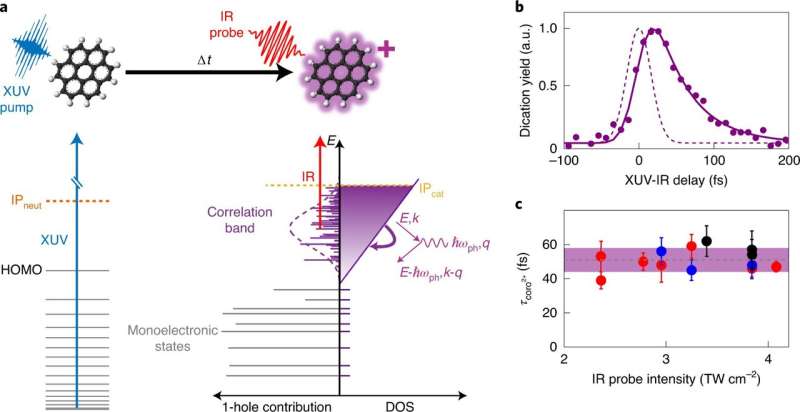Dynamics in correlation bands. a, Ionization of the inner-valence shells of molecules, well below the highest occupied molecular orbital (HOMO), by an XUV pump pulse (left) leads to the formation of a correlation band (CB) composed of a multitude of strongly coupled multielectronic states below the double ionization threshold, IPcat (right). The CB in PAHs can then be described as a solid-like band with a linear density of state (DOS). The subsequent relaxation occurs through electron–phonon scattering and is probed by ionization with the delayed infrared pulse, creating a stable dication. b, Measured dication yield as a function of the XUV–IR delay for coronene (purple dots), together with the exponential fit (purple full line), and the cross-correlation between the pump and the probe pulses (dashed line). c, Measured relaxation time in coronene as a function of the probe intensity, for different XUV spectra. The associated error bars correspond to the standard deviation of the fitting procedure for each measurement. Credit: Nature Physics (2020). DOI: 10.1038/s41567-020-01073-3
A team of researchers from Institut Lumière Matière, Universität Heidelberg and Leiden University has found via study of a whole class of polycyclic aromatic hydrocarbons (PAHs) that such molecules follow the same relaxation pathways and have size-dependent lifetimes—and behave more like solids than is typical for molecules. In their paper published in the journal Nature Physics, the group describes their work, which involved studying what happens when ultrashort X-rays are fired at large and complex molecules. Laura Cattaneo with the Max Planck Institute for Nuclear Physics has written a News and Views piece outlining general work involved in trying to understand photochemistry in complex big molecules and the work done by the team on this new effort.
As Cattaneo notes, much work has been done by researchers to better understand what happens in chemical reactions at the molecular and nuclear levels, with some progress. But as she also notes, the same cannot be said for study of the photochemistry involved in large, complex systems. This is because the work involved in such experimentation is quite complex. In this new effort, the researchers forged ahead regardless of the complexity by conducting whole class experiments on PAHs as they are struck by X-rays.
Prior work has shown that ionizing radiation striking a molecule creates a hole. These holes have been found to migrate—but they do so very quickly, on the order of attoseconds. Cattaneo points out that this migration implies some degree of correlation among the various orbital configurations. In this new effort, the researchers sought to learn more about these migrations.
They found a universal effect regarding correlation bands, which come about due to electron correlation—long lifetimes that increased in a nonlinear fashion related to the number of valence electrons. Their observations showed that such molecules all follow the same relaxation pathways and have size-dependent lifetimes—and they generally behave more like solids than is generally seen in molecules. They suggest their observations imply a new law-based on the solid-like electron properties involved with phonon scattering.
More information: M. Hervé et al. Ultrafast dynamics of correlation bands following XUV molecular photoionization, Nature Physics (2020). DOI: 10.1038/s41567-020-01073-3
Laura Cattaneo. A solid look at molecules, Nature Physics (2020). DOI: 10.1038/s41567-020-01080-4
Journal information: Nature Physics
© 2020 Science X Network
























